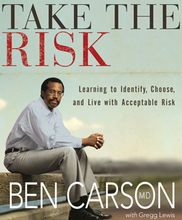February 21, 2008 Silver Spring, Maryland, United States…Taashi Rowe/ANN
The word “risk” often implies choosing for a moment or a lifetime reckless and dangerous abandon. But for Dr. Ben Carson, world-renown chief of pediatric neurosurgery at the Johns Hopkins University Medical Institutions in Baltimore, Maryland, United States, too many people don't take enough risks.
In his latest book, “Take the Risk: Learning to Identify, Choose, and Live with Acceptable Risk,” Carson makes a case for risk-taking by looking at the upside of risky behavior.
“There are so many people who never accomplish in life much of anything because they don't take any risks,” Carson told Adventist News Network in a recent interview about the book.
No stranger to risk himself, Carson, who probes into live human brains on a regular basis, shares his formula for taking “appropriate risks” and takes readers into the operating room as he undertakes some of the world's most risky surgeries.
For those who have heard Carson's story ? of going from a failing, at-risk kid growing up in Detroit, Michigan to becoming one of the world's most respected pediatric neurosurgeons — his fourth book gives risk a bigger but somewhat familiar role in his well-publicized life story.
In the book, which was released last month, he remembers nearly failing his first year of medical school. His advisor suggested that he either drop out of school or take a reduced course load. Carson refused to do either. Instead, he analyzed how he learned best — independent study — and then stopped attending lectures.
Another story on risk involves a little girl from Mexico who suffered from constant seizures. Carson recommended a hemispherectomy, which involved removing the part of her brain causing the seizures. A noted neurosurgeon at the hospital lobbied against the procedure, calling it reckless.
“It was a risky operation,” Carson admitted. “But there was a possibility that the seizures would go away and she would get her life back.”
After doing what he calls a “best/worst analysis,” where he asked himself the best and worst outcome of both performing the operation and doing nothing, Carson went ahead. The surgery was successful and today the girl is a healthy adult.
At its core Carson's book is about teaching readers by example, how to take risks. “Doing a best/worst analysis forces you to appropriately consider the risks rather than going headlong into a situation and seeing what happens,” Carson said.
The book covers various aspects of personal, academic and professional risks. He also reserves two chapters of his book to discuss the risk of living a life of faith. In these chapters he shares how consistently adhering to his faith has been a boon to his academic and professional life.
At 240 pages, Take the Risk is by no means an in-depth academic study on all things risk. However, it is not to be dismissed. Carson's honest and simple approach make him a believable teacher on how to make decisions involving great risk.
“God did not make us to be shy, retiring wall flowers,” Carson said. “He made us to be people who can sit down, analyze what our gifts and talents are, look out there and see what the issues are and then move forth in a very logical and rational way, not being paralyzed by fear.”
Carson has written three other books: “Gifted Hands: The Ben Carson Story,” “Think Big: Unleashing Your Potential for Excellence” and “The Big Picture: Getting Perspective on What's Really Important.”
-Adventist News Network
